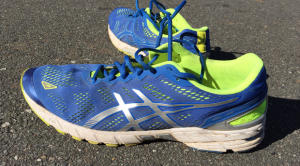Last May Nike tried the break the 2 hour barrier for the 26.2 mile distance. Its technical contribution to the paced-event on a Monza race track in Italy was a new shoe.
The shoes used for this exercise were built to match the shape of the foot of each elite runner, and with the runners’ input. These marathoners asked for more cushioning than they had in the shoes they had been running in. This I found interesting because the trend is toward racing flats that are lighter but that have less cushion (or, it was before Hoka barged in and altered the trajectory).
We had an interest in this shoe for the obvious reasons, but also because of proximity: Our retail store is just around the corner from the Nike EMEA headquarters. Although we are not a Nike dealer a lot of their employees come in to chat, to discuss product, and to buy tri stuff. Not that these employees blabbed about the shoe! Just, that special project has since translated into a product for sale and therefore I thought I’d write about it.

The Zoom Fly and the other version, the Zoom Fly 4%, flow from the models used by the Breaking 2 project (below). The 4% is the more expensive and lighter version with a full carbon plate. Very hard to get your hands on! And I haven’t yet! So that review is still forthcoming. It’s just the Fly in this review.
First the upper: Light, flexible and pretty breathable. It fits like a sock – remember Nike’s pedigree with it’s 80s-era Sock Trainer and Racer – and the forefoot area also feels more like a sock with just a very minor supportive piece at the toes. The laces are held in place not by the regular holes but with (something like) Flywire loops. These loops create a very nice compact fit.
The tongue is thin but not overly, and has a little cut out for the tendon that runs from your big toe back toward your ankle. It is a small but well-conceived feature and expresses how much Nike considered minute details. I’d never thought of it but now that I’ve experienced it I’d like to have it in all my shoes, in particular when I run sockless.

The design of the heel is an item of discussion for users – on the high side for a fair number of them. I didn’t have any trouble. No rubbing on my Achilles tendon. Nevertheless, high it is.
The midsole, however, is the technical achievement here. The Zoom Fly comes with a carbon infused nylon plate, which is a little heavier than the full carbon plate that is used in the 4% version. Is it also less stiff? Don’t yet know. Would I want it stiffer? Don’t know. Just, the forefoot of the standard Zoom Fly is certainly stiff, much stiffer than you would expect. While they are stiff and hardly bend under your forefoot they still are super soft. It took me a few kilometers to get a feel for the shoes; how to adjust my footfall; how to acclimate to energy absorption-return during the toe-off.
Sounds pretty good, yes?! Maybe. Having spoken to a fair number of users, a lot depends on your footstrike. A fair number of forefoot strikers can’t get it right, clapping to ground with an audible noise. Way fewer issues for heel and midfoot strikers. Most of these founds the shoes soft, but not soft and slow; rather soft and fast. I had several of my best and fastest training runs of the season in them. And I’m not a particular fan of soft shoes.

What I feel with most cushioned shoes is a bit of drift underneath me, especially around corners. The shoes drifts a bit away from under your feet and Hoka’s Cliftons are a case in point. I experience less of this with the Zoom Fly. I ascribe the difference to the rather stiff plate in the shoe.
Why is this shoe fast for me? The plate? The angle and aspect of the plate in the shoe? Another large shoe company made a shoe with a carbon plate under the forefoot upwards of a decade or so ago, the plate perhaps a little longer, my memory of it is vague, I seem to recall they marketed it as the carbon plate would store and return energy during the toe-off. But I don’t remember it working, or working well enough to stick.
I am left therefore to say that it works, but not for certain why it works. I run faster, with less effort, and recover well. I can also run in them at lower speeds, but they don’t come into their own until you’re running at a high effort.

These are not low-drop shoes; they are built on a 10mm drop platform, but I didn’t feel like I was running in pumps, perhaps because of the deflection in the heel, maybe it’s the energy return in the toe-off. To be clear, a shoe like this is not entirely foreign to Nike. Search the Air Mariah and you’ll see a fairly similar silhouette in a shoe Nike built roughly a quarter-century ago.
The outersole of the Zoom Fly has strategically-placed rubber pads and a full forefeet piece of rubber that seems to abrade slowly. After over 300 miles my shoes have no serious wear on them. You may see wrinkles in the midsole foam after just one run, mine did, but they felt no less cushioned.
The Nike Zoom Fly retails for $150 and is available in men’s- and women’s-specific sizes and colors.
The weight is 8.75oz in a men’s size 10.



